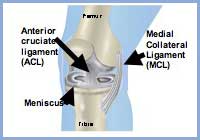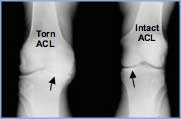Clinical Problem | Overview
Injuries to the ACL and meniscus are common in the United States. Each year there are over 100,000 ACL tears, and over 500,000 meniscal tears. These injuries are most common in patients under the age of 44.(1)
In routine examinations of the inside of young people's knees, I have been struck by the lack of healing seen for tissues inside the knee - tissues including ligaments, the menisci and the articular cartilage (Fig 1).
Failure of these tissues to heal has been known by orthopedists for almost thirty years.(8,16) Traditionally these injuries have been treated with either simple excision of the tissue (7) or replacement with autograft or allograft tissue.(5)
Unfortunately, neither removal nor replacement prevents the premature onset of osteoarthritis (7,15,18) (Fig. 2). Current treatment methods, for those who sustain ACL injuries in the US each year, has shown to result in premature osteoarthritis in 70% of patients at only 14 years after injury.(18) Rates of premature osteoarthritis after meniscectomy approach 50% at 12 years, (11) and reach as high as 87% at 16 years when the meniscus is removed in children.(6)
We seek new ways to effectively treat these injuries, and to help prevent young patients with these injuries from developing a disease of old age in their twenties and thirties.

Fig. 1: Examples of tissues inside joints. The ACL is a central stabilizer of the knee, connecting the femur and tibia. The menisci are shock-absorbers on either side of the knee which enhance the congruity of the curved surfaces. The articular cartilage covers the ends of the bones and provides a gliding surface with less friction than ice-on-ice.
High Failure Rate
Why does a mechanically strong suture repair of the anterior cruciate ligament (ACL) inside the knee fail 90% of the time,(8) while the medial collateral ligament a few centimeters away (and outside the knee joint) heals even without sutures? (9,16)
Why is there a failure of healing for tissues inside joints?
-
Rotator cuff fails to heal over 90% of the time after suture repair.(10)
-
Meniscus fails to heal after suture repair at least 40% of the time, even in the small proportion of tears selected carefully as the best suture repair candidates.(12,17)
-
Articular cartilage injuries have a limited healing response with or without debridement, and have only a limited healing response even with the addition of transplanted cells.(13)
 Fig. 2: Premature osteoarthritis after an ACL injury. X-ray of a 40 year old man who had sustained an ACL rupture 20 years earlier. Note the joint space narrowing and osteophyte formation consistent with premature osteoarthritis (arrow) on the medial aspect of the left knee (knee with ACL tear) and the preservation of medial joint space in the knee with the intact ACL on the right (arrow).
Fig. 2: Premature osteoarthritis after an ACL injury. X-ray of a 40 year old man who had sustained an ACL rupture 20 years earlier. Note the joint space narrowing and osteophyte formation consistent with premature osteoarthritis (arrow) on the medial aspect of the left knee (knee with ACL tear) and the preservation of medial joint space in the knee with the intact ACL on the right (arrow).
Stimulating healing of injured tissues inside joints is arguably the most important problem in orthopedic science today. Successful restoration of these tissues and subsequent control of joint mechanics and function promises to change the epidemiology of osteoarthritis. Prevention of premature osteoarthritis could significantly impact not only the individual lives of our patients, but could also reduce the health care expenditures for this disease, which are estimated to cost the US economy over 60 billion dollars per year.(4)
